(完整版)英语人教版八年级下册unit1SectionA教学设计
- 格式:doc
- 大小:13.34 KB
- 文档页数:4

Unit1 What’s the matterPeriod One (Section A:1a-1c)Teaching aims:1.Knowledge aims:1)Ss can use the following words and phrases: head , ear, eye, mouth, nose,throat , neck, back, hand, arm, leg, tooth-teeth, foot-feet , matter, have a cold, stomachache, , backache, headache, toothache2)Ss can use the following sentence patterns:What’s the matter? I have a stomach./I have a sore back./I have a cold.He/She has a sore throat.What should I do? You should …2.Ability aims: Learn how to talk about health problems and give some advice3.Emotion aims: Let the Ss know keeping healthy is importantImportant & difficult points:Learn how to talk about health and give some advice.Teaching aids: computerTeaching design:Step 1 Warming-upSing an English song: If you’re happy.Step 2 Word study1. T: Are you happy?S: Yes, we are.T: When we’re happy, we can clap our hands and stamp our feet. Hands and feet are parts of our body, look at the boy, can you say other parts of our body in English?S: Yes ,I can.2.Present a picture of a baby. let the Ss say the parts of the body.3.Work on Section A 1a4. Play a game: Touch the parts of your body1)Let the whole class touch the parts of their body when teacher say: Touchyour…2)Ask six Ss to come to the front and do as the teacher tells them: Touchyour…if one does wrong, let him or her go back, the last one who in the front is the winner.(clap hands)Step 3 Presentation and practice1. T: Are you happy? Ss: Yes, we are.T: Look at the picture, is he happy?Ss: No, he isn’t.T: Why?(Help the Ss to answer: He has a stomachache.)2.Present other pictures, talk about health problems of the persons in the pictures. What’s the matter? He/She has a headache/ toothache /a sore back/ a sore throat/a cold and a cough.3. Let the Ss practice in pairs4. T: Suppose there is something wrong with your body .You may say: I have a headache. I have a sore throat.Step 4 ChantHead, head, I have a headache. I have a headache,Stomach, stomach, I have a stomachache. I have a stomachache,Ear, ear, I have an earache. I have an earache,Tooth, tooth, I have a toothache. I have a toothache.Back, back, I have a sore back. I have a sore back,Throat, throat, I have a sore throat. I have a sore throat.Oh, dear! Do more exercise, please and keep healthy!Step 5 listen and say1.Work on Section A 1b, listen and number the names 1-5.2.Listen again and talk about the health problems of the persons in the picture.Eg: Nancy has a toothache, Sarah has a cold,…Step6. PresentationGuessing gameThe teacher shows some part of the pictures to the Ss and let them guess .T: What’s the matter with him/her?S: Does he/she have a …?T: Yes, he/she has a cold. Can you give him/ her some advice? Whatshould he /she do?S: He /She should drink hot tea with honey/ shouldn’t speak more/ go to see a doctor… (Ss can give different advice as they like)T: What’s the matter with him/her?S: Does he/she have a …?T: Yes, he / she has a / an toothache /fever / headache / earache…Whatshould he /she do?S: He /She should go to see a dentist / shouldn’t eat ice cream/shouldn’tdrink cold water /lie down and rest / shouldn’t play basketball/ shoulddrink a lot of water./should see a doctor…Step7. PracticeGroup-work. Role play the conversations in 2b. Let the Ss read the conversations first. Then work in a group, make a new conversation .A: What’s the matter?B: My head feels very hot.A: Maybe you have a fever.B: What should I do?A: You should drink hot water and take some medicineStep 8 Summary。
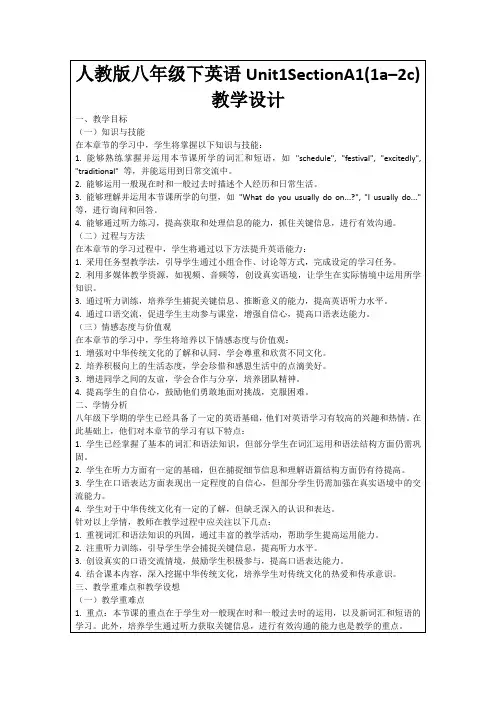
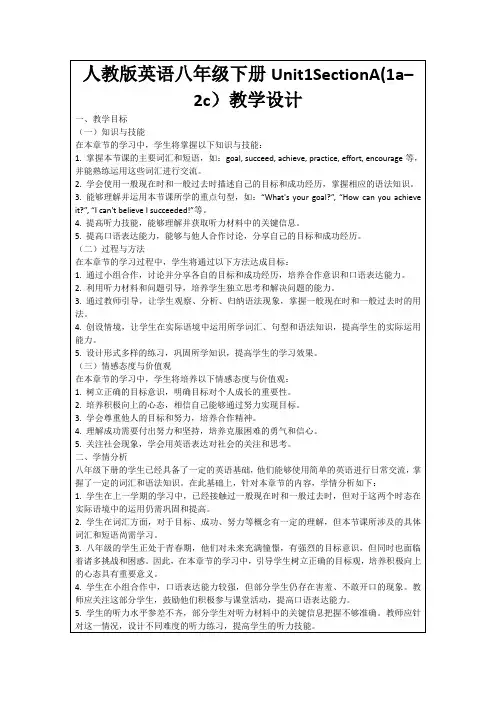
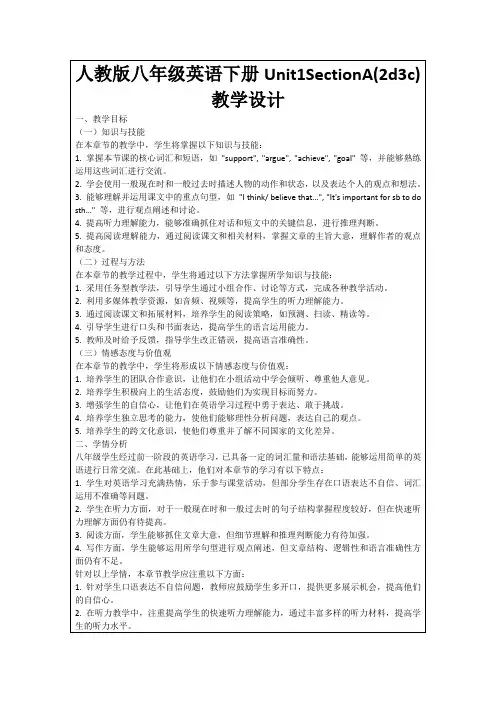

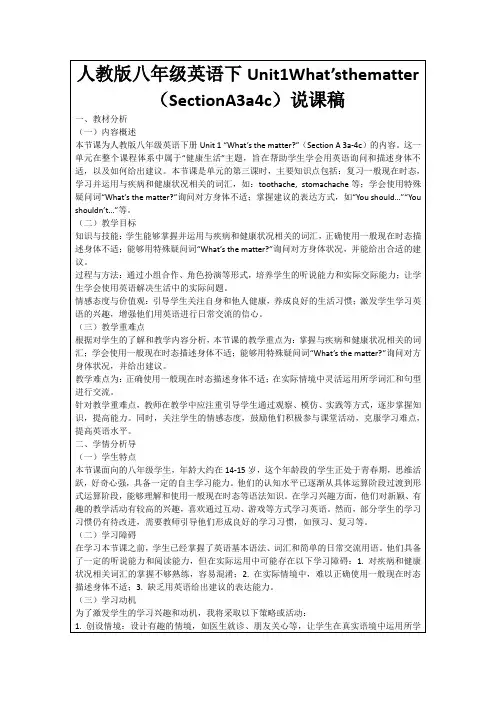
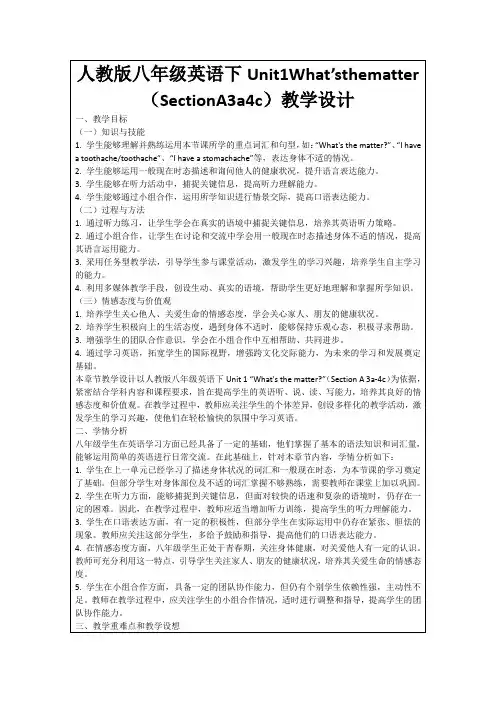
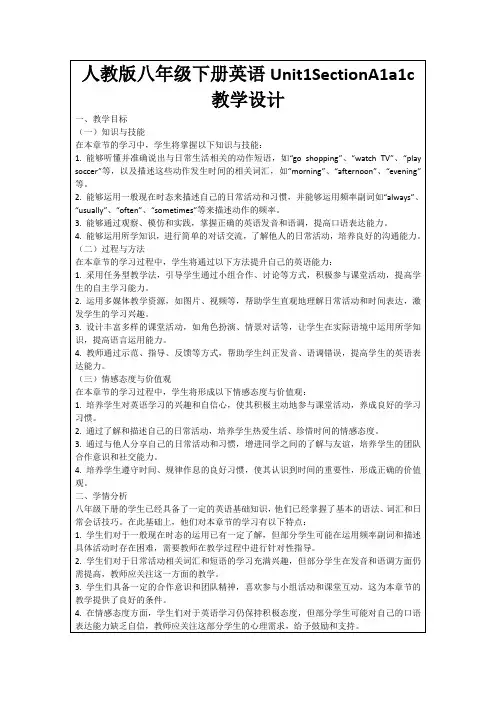
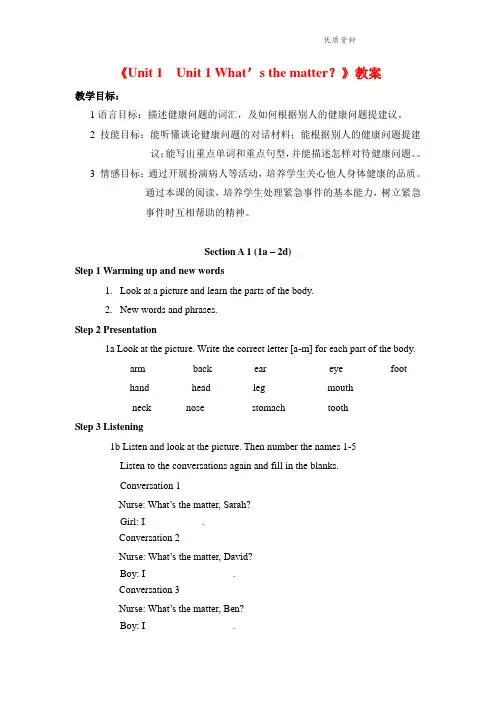
《Unit 1 Unit 1 What’s the matter?》教案教学目标:1语言目标:描述健康问题的词汇,及如何根据别人的健康问题提建议。
2 技能目标:能听懂谈论健康问题的对话材料;能根据别人的健康问题提建议;能写出重点单词和重点句型,并能描述怎样对待健康问题。
3 情感目标:通过开展扮演病人等活动,培养学生关心他人身体健康的品质。
通过本课的阅读,培养学生处理紧急事件的基本能力,树立紧急事件时互相帮助的精神。
Section A 1 (1a – 2d)Step 1 Warming up and new words1.Look at a picture and learn the parts of the body.2.New words and phrases.Step 2 Presentation1a Look at the picture. Write the correct letter [a-m] for each part of the body.___arm ___ back ___ ear ___ eye ___ foot___hand ___ head ___ leg ___ mouth___ neck ___nose ___ stomach ___ toothStep 3 Listening1b Listen and look at the picture. Then number the names 1-5Listen to the conversations again and fill in the blanks.Conversation 1Nurse: What’s the matter, Sarah?Girl: I ___________.Conversation 2Nurse: What’s the matter, David?Boy: I _________________.Conversation 3Nurse: What’s the matter, Ben?Boy: I _________________.Conversation 4Nurse: What’s the matter, Nancy?Girl: I _________________.Conversation 5Betty: What’s the matter, Judy?Ann: She __________________.Step 4 Speaking1c Look at the pictures. What are the students’ problems? Make conversati ons.ExamplesA: What’s the matter with Judy?B: She talked too much yesterday and didn’t drink enough water.She has a very sore throat now.A: What’s the matter with Sarah?B: She didn’t take care of herself on the weekend. She was p laying withher friends at the park yesterday. Then it got windy, but she didn’t puton her jacket. Now she has a cold.Step 5 Guessing gamesGuess what has happened to the students by using the important sentenc es. Step 6 Listening2a Listen and number the pictures [1-5] in the order you hear them.2b Listen again. Match the problems with the advice.Step 7 Speaking2c Make conversations using the information in 2a and 2bA: What’s the matter?B: My head feels very hot.A: Maybe you have a fever.B: What should I do?A: You should take your temperature.Step 8 Role–playImagine you are the school doctor. A few students have health problems.Role-play a conversation between the doctor and the students.2d Role –play the conversationStep 9 Language points and summary1. What’s the matter?这是人们特别是医生和护士询问病人病情时最常用的问句, 意思是“怎么了?”其后通常与介词with连用。
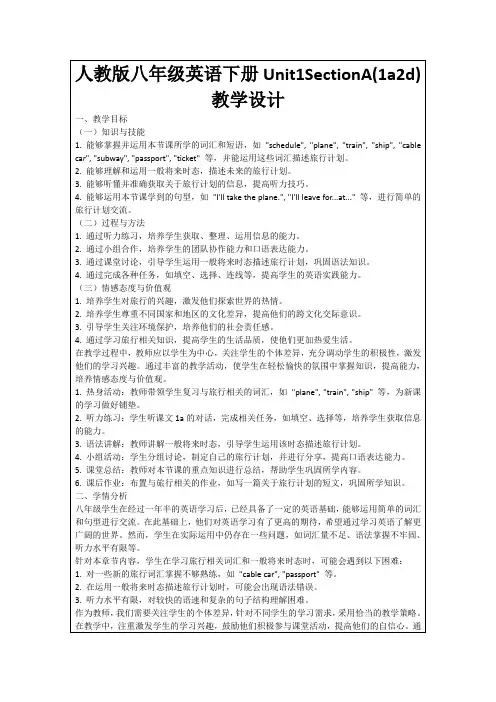
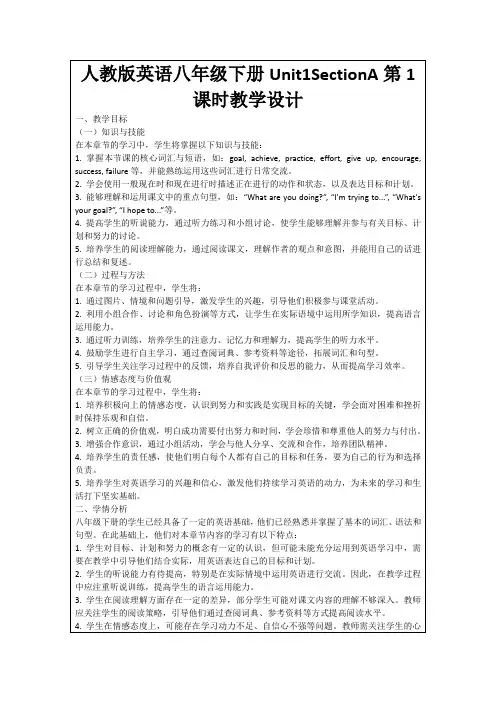
Unit 1 What's the matter?第一课时Section A (1a2d)【教学目标】1.重点单词:matter,back,sore,throat,stomachache,foot,neck,stomach,fever,lie,rest,cough,Xray,toothache,headache2 重点短语:have a sore throat,have a stomachache,have a cold,lie down,take one's temperature,have a fever,go to a doctor3 重点句式:—What's the matter?—She talked too much yesterday and didn't drink enough water.She has a very sore throat now.You should drink some hot tea with honey.It doesn't sound like you have a fever.You need to take breaks away from the computer.I think I sat in the same way for too long without moving.If your head and neck still hurt tomorrow,then go to a doctor.【学习重点】1 重点短语和句型2 询问对方身体状况的句型及答语【学习难点】询问对方身体状况的句型及答语【自主学习】一、预习课本P12新单词并背诵,完成下面的汉译英。
1 问题____________ 2.背部____________3 疼痛的____________ 4.嗓子____________5 胃痛____________ 6.脚____________7 脖子____________ 8.胃____________9 发烧____________ 10.平躺____________11 休息____________ 12.咳嗽____________13 X光____________ 14.牙疼____________15 头疼____________二、认真预习1a2d找出下列短语和句型。
Unit 1 What’s the matter?Section A (1a—2d)一、教学目标1. 能够熟练掌握本课重点词汇:matter, sore, stomachache, foot, neck, stomach, throat, fever, lie, rest, cough, X-ray, toothache, break, hurt,have a cold, have a stomachache, have a sore back, havea sore throat, lie down, cut oneself, take one’s temperature, have a fever, take breaks等。
2. 熟练运用本课重点句型:(1) —What’s the matter?—I have a…(2) —What should I do?—I think you should lie down and rest.3. 能够听懂谈论健康问题的对话,并能从中提取关键信息。
4. 能够使用“have+(a)+疾病”结构描述健康问题,并能就健康问题提出简单的建议。
5. 学会关心自己和他人,通过询问他人的健康情况并给予帮助,从而增进人与人之间的感情。
二、教学重点及难点重点:1. 能够听懂谈论健康问题的对话,并能从中提取关键信息。
2. 能够使用“have+(a)+疾病”结构描述健康问题,并能就健康问题提出简单的建议。
难点:能够使用“have+(a)+疾病”结构描述健康问题,并能就健康问题提出简单的建议。
三、教学过程四、板书设计Unit 1What’s the matter?第1课时Section A (1a—2d)Key words and phrases: matter, sore, stomachache, foot, neck, stomach, throat, fever, lie, rest, cough, X-ray, toothache, break, hurt,have a cold, have a stomachache, have a sore back, have a sore throat, lie down, cut oneself, take one’s temperature, have a fever, take breaksKey sentences:1. —What’s the matter?—I have a…2. —What should I do?—I think you should lie down and rest.。
Unit 1 What’s the matter?Section A (1a-2d)一、教学目标1. 听懂并掌握下列词汇及常用表达:matter, sore, stomachache, foot, neck, stomach, throat, fever, lie, rest, cough, X-ray, toothache, headache, break, hurthave a cold, have a stomachache, have a sore back, have a sore throat, lie down, cut oneself, take one’s temperature, have a fever, take breaks2. 听懂谈论健康问题的对话材料。
3. 能简单谈论健康问题,并使用“have + (a) + 病症”结构做出回答或表述。
What’s the matter with …?I have a …4.掌握听力技巧之利用生活常识听前预测。
5. 能够运用所学的语言简单地描述自己的健康状况并询问对方的身体健康状况。
6. 学会关心他人,通过询问他人的健康情况并能给予帮助,增进人与人之间的感情。
二、教学重点及难点重点:1. 掌握核心词汇及常用表达。
2. 能简单谈论健康问题,并使用“have + (a) + 病症”结构做出回答或表述。
难点:掌握听力技巧之利用生活常识听前预测。
三、教学准备1. 教学课件、词汇图片。
2. 学生课前预习。
四、教学过程Task 1(1a-1c)Step 1 Warming-upLook and sayT: Welcome to our new class. Today we’ll learn Unit 1. First you will see some pictures of body parts. You can look at the pictures and say the corresponding words.设计意图:复习已学的单词,为本单元“健康与急救”话题的学习奠定基础。
中学英语《Unit1 What’s the matter?》教学设计
一、教案背景
1、面向学生:中学
2、教材版本:人教版八年级下册
3、学科:英语
4、课时:1课时
5、学生课前准备:
二、教学课题
(一)教学目标和要求
知识目标:1、学习并掌握重点词汇:stomachache throat fever cough toothache headache等。
2、学会如何询问健康问题。
3、能够运用have to、should、shouldn't来给出合理的建议。
能力目标:能够运用所学知识自如地谈论健康问题。
情感目标:通过本课的学习,使同学们学会关心自己及他人的身体健康状况。
(二)教学重点和难点
教学重点:1、新词汇和新句型.
2、通过对健康问题的探讨,让学生能够熟练掌握并运用What’s the
matter? I have a\an...等有关健康问题的日常交际用语。
教学难点:1、能正确使用What’s the matter?及have+(a)+病症等结构谈论健康问题。
2、能够正确使用情态动词should给出恰当的建议。
三、教材分析
本节课选自人教版八年级下第一单元“What’s the matter? ”的section A部分.本单元通过对健康这一人们生活中必不可少话题的谈论,让学生们学会关于谈论健康状况的一些日常交际用语。
在本课的教学过程中也会通过对表述身体不适句型结构的分析以及情态动词should一词的讲解,让学生进一步掌握有关伤病及处理建议的表达方式。
本节课的教学重点在于对新单词和句型的熟练掌握,只有熟练的掌握才能自如的运用。
难点在于将所学知识熟练的运用,并且能够根据不同的健康问题给予合理的建议。
在教学准备过程中我搜索到了一些与本课相关的能够令学生们感兴趣的图片、录音,寓教于乐让学生们积极的参与到教学过程中,让他们能够充分体会到学习的快乐。
调动他们学习英语的积极性,充分展示学生在教学中的主体地位。
四、教学方法
运用task-based method(任务型教学法),借助多媒体手段创设情境让学生产生兴趣,而积极主动的投入到语言环境中。
充分发挥学生在教学过程中的主体地位,将语言知识和语言技能结合起来,培养学生的语言综合运用能力。
在活动中学习知识,提高学生参与的积极性,最终养成良好的学习习惯。
五、教学过程
一、Greet the class
T: Good morning class.
Ss: Good morning teacher.
T: Long time no see, welcome to my class. Let’s start the study.
二、New words
T: Today let’s learn the names of the body parts. Please look at the picture on the
screen. What’s this?
Ss: It’s a nose.
T: Yes, you’re right. Do you know other parts of the body?
Ss: head mouth…
T: Well done. I’ll give you more pictures about the parts of the body. Read after me A-R-M arm.
Ss: A-R-M arm
(Teach the other new words in the same way such as neck\back\leg\stomach…) T: OK, let’s do some practice. Look at the picture in 1a and write the letter for each part of the body.
(Check the answers in class)
三、New drills
T: What’s the matter?
(The teacher mines having a headache and writes it on the blackboard) then say:
I have a headache. (teach the other illness such as have a stomachache\have a cold
\ have a fever…in the same way)
T: Now I’ll show you some pictures about the illness. Please make a conversation like this.
S1: What’s the matter?
S2: I have a … (Ask some pair students to presents their conversations)
T: Good job. Let’s look at the picture again. There are some students in the hospital.
They’re not feeling well. Please listen carefully and number the names [1-5].
(Check the answers)
四、Practice
T: Let’s do some listening practice. Look at the picture in 2a. The people are talking about their health problem. Please listen carefully and number the pictures [1-5] in order you hear them. T: Who can share you answer with us?
S: …
(Check the answers)
T: There is something wrong with the people in 2a. What should they do? I’ll play the recording for the second time. Please try you best to match the problems with the advice.
T: I have a fever. What should I do? S: You should take your temperature. (check the other answers like this)
T: We’ve known how to talk about health problems and ask for advice. It’s time to work in pairs. Please make your own conversations using the information in 2a and 2b
T: Who can report your conversations to us?
S1: …Are you OK? / What’s the matter?
S2: …
T: Read the conversation between Mandy and Lisa carefully. Then I’ll invite some of you to role-play the conversation.
(Give them some help if they need.)
Ss …
Homework
1、Remember the new words and target languages.
2、Make a dialogue by asking and answering like a doctor and a patient.
六、教学反思
本课旨在让学生学会利用所学知识来表达对身体健康状况的问询。
本课充分围绕电影这一话题,通过对身体健康的谈论让学生熟练掌握新的词汇和句型。
在教学过程中我采用了任务型教学法,并针对中学生猎奇心理,用图片,音频等激发其学习兴趣。
这些贴近生活的资料,会给学生一个学习的动力,让他们有明确的目标,充分调动他们的积极性。
教学过程中老师给予适当的指导,相信会取得较好的效果。